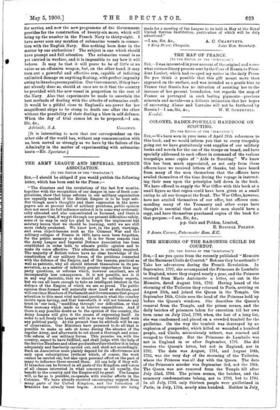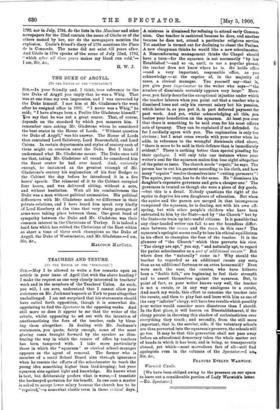THE MEMOIRS OF THE BARONESS CECILE DE COTJRTOT.
[TO THE EDITOR OF THE "SPECTATOR."] see you quote from the recently published "Memoirs of the Baroness Cecile de Courtot." But can they be authentic ? Take her adventures during the French Revolution. In September, 1791, she accompanied the Princesse de Lamballe to England, where they stayed nearly a year, and the Princess received from Marie Antoinette a letter, set out in the Memoirs, dated August 10th, 1792. Having heard of the storming of the Tuileries they returned to Paris, arriving on August 25th, and joined the Queen in the Temple. On September 18th, Cecile sees the head of the Princess held up before the Queen's windows. She describes the Queen's removal from the Temple, and the prison scenes, and the daily batches of prisoners taken for execution till her own turn came on July 22nd, 1793, when, the last of a long list, she was condemned and placed on a crowded tumbril for the guillotine. On the way the tumbril was destroyed by an explosion of gunpowder, which killed or wounded a hundred people, and Cecile, miraculously unhurt, was rescued and escaped to Germany. But the Princesse de Lamballe was not in England in or after September, 1791. She did receive the Queen's letter, but not in England, nor in 1792. The date was August, 1791, and August 10th, 1792, was the very day of the storming of the Tuileries, where the Princess was all day with the Queen. The date of the Princess's murder was September 3rd, not the 18th. The Queen was not removed from the Temple till after July 22nd, 1793. The prison scenes, the batches, and the summary condemnations belong, not to 1793, but to 1794. In all July, 1793. only thirteen people were guillotined in Paris; in July, 1794, nearly nine hundred. Neither in July,
1793, nor in July, 1794, do the lists in the Moniteur and other newspapers for the 22nd contain the name of Cecile or of the others named by her, nor do the newspapers mention the explosion. Cecile's friend's diary of 1794 mentions the Place de la Concorde. The name did not exist till years after. And Cecile in 1794 speaks of the scene of July 22nd, 1793, "which after all these years makes my blood run cold."—







































 Previous page
Previous page